
KJ
Action and Adventure - Research
Conventions of Action/Adventure Films:

Click on the image to view and exit the mind map desplay!

Click on the image to view and exit the mind map desplay!
The Hunger Games: Catching Fire

Outline of The Hunger Games:
The Hunger Games is an action/adventure film based on the original book novel "The Hunger Games Trilogy". Set in a dystopian, post-apocalyptic nation of Panem in North America, Katniss Everdeen (Jennifer Lawrence) took her sisters place in completing a nationally televised event called 'The Hunger Games', where one boy and girl from each 12 districts, aged 12-18, are forced to fight in a battle royal arena as a punishment for the previous rebellion against the powerful nation of Panem, the Capitol. The Hunger Games: Catching Fire takes place after the events of 'The Hunger Games', where Katniss now have to face another upcoming 75th Hunger Games, known as the third quarter quell, where previous victors are forced to fight in this event.
Director: Francis Lawrence
This is a video clip of Katniss training in a holographic room, taken from The Hunger Games: Catching Fire. This clip shows how the fast cuts creates tense and action to the video. Click the arrow at the centre to watch!

Mis-En-Scene:
The characters are very distinct towards each other, as the setting of the protagonist is in a heavily povertised zone called district 12. The clothings in district 12 are mostly made to be fashioned in a modern, casual design, where as the female character from the Capitol dressed in orange-yellow colour and wearing a wig, is represented as a rich citizen, conveying this strong division with the stereotype of the rich and the poor. Additionally, Katniss wears a dark navy blue clothing which reflects her weak side of her persona before we are introduced to her strong, heroic character.
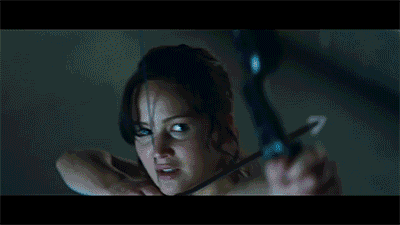
Editing:
The use of fast cuts creates tense and action to the video. This allows us to see the exampled scene where Katniss shoots the arrow to the holographic machine and the machine breaks into pieces. This matches to the conventions of how action films are required, as fast cuts demonstrates how powerful the protagonist or antagonist are unlikely to be taken down.
Sound:
Diegetic sound is included to the scene where Katniss shoots the final arrow to the holographic image of the cube shaped character. The sound of the holographic character quickly broken into pieces help viewers to feel that what they are seeing is real and matches to how much damage a single arow can do. This reflects to how the protagonist is represented to be well built and dexterous.
Camera

This high-angle longshot reveals the distinction between the rich (Elizabeth Banks as Effie) and the poor. Although the two side characters (Jennifer Lawrence as Katniss and Josh Hutcherson as Peeta) appear to be wearing smart, well tailored clothes, their colour props highlights that they are from the poorer districts, which matches to their strict, cautious expression.

This low-angle closeup shot reveals the protagonist's sense of fear, as she is transported to the death royal arena. This creates tension to the viewers, as we see the protagonist is being tested on her fight for survival.

This middle-angle extreme longshot reveals the true character of the protagonist, revealing her true courage instead of her frail status. The purpose of the protagonist being in the centre of the interview stage, with her Mockinjay wings, is to symbolise that she is the character who will lead an uprising for the rebellion against the Capitol, thus causes viewers to support her.
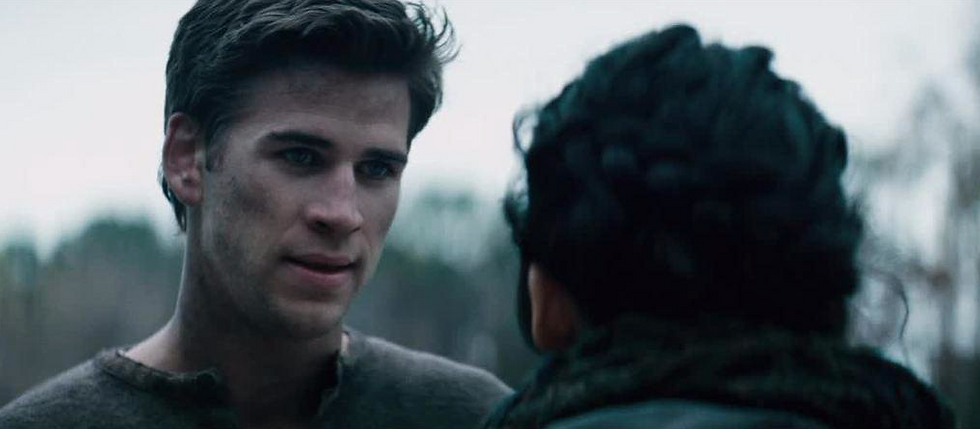
This over the shoulder shot reveals Gale's(Liam Hemsworth) facial expression and his sense of fear towards life in district 12. The use of this shot was to make the side characters to be the main focus of the protagonist's responsibility, thus matching the conventions of the protagonist carrying the weight of protecting her friends.

This middle angle closeup shot of the protagonist with the background of many poor people, reveals how the protagonist felt towards being unable to protect her two friends (Dayo Okeniyi as Thresh and Amandla Stenberg as Rue). Further more from observing this shot, this also causes viewers to feel tense and dejection towards the characters, who mourn the deaths of those who took part in the Hunger Games from the first film.

This side angle close-up shot reveals the protagonist's complete grief of starting the Hungers Games again, after experiencing the death of 22 people from her last games. Furthermore, she appears to later be staring at the viewers, which makes them feel sympathy towards the protagonist's struggles.
Click the images to view the written text that explains about the use of these camera shots. When on image view, click the arrows that is displayed on the left/right screen to view the next slide.
Big Hero 6
Outline of Big Hero 6:
Big Hero 6 is an animated film with a mixture of action, adventure and sci-fi genre.
Robotics prodigy Hiro (Ryan Potter) lives in the city of San Fransokyo, with his older brother, Tadashi (Daniel Henney) and Aunt Cass (Maya Rudolph). Tadashi's greatest invention and companion is Baymax (Scott Adsit), who is a robot whose sole purpose is to take care of people. When a devastating turn of events throws Hiro into the middle of a dangerous situation, he transforms Baymax and his other friends, Go Go Tamago (Jamie Chung), Wasabi (Damon Wayans Jr.), Honey Lemon (Genesis Rodriguez) and Fred (T. J. Miller) into a band of high-tech heroes.
Directors: Don Hall and Chris Williams

This is a video clip of Hiro's gang trying to escape by car from the mask man. This clip demonstrates how the fast cuts creates tense and action to the car chase video. Click the arrow at the centre to watch!

Mis-En-Scene:
The characters are mostly been customised into casual clothes that matches to our day to day modern world. Although the film genre is science fiction, there is a depiction of modern icons being in harmony with futuristic icons, as this creates a sense of realism for example, the setting combination of San Francisco and Tokyo. The characters are mostly modeled to target youth audiences, thus reflecting to disney's target audience for family entertainment. Baymax (Scott Adsit) however is a ballon like robot who is the main representation of the genre of this film. His appearance is completely white with two black dot eyes, which further conveys his robotic appearance that tells the film's genre (i.e. Sci-Fi).
Editing:
From watching the video clip, where we get to see the gang take action of escaping from the mask man, we see alot of cuts combined with some establishing shots to display where the action is taking place, but also it makes the viewers feel a sense of suspense and suprise to Gogo's fast driving action. Furthermore, this use of fast cuts describes Gogo tomboyish personality, thus desplaying her fearless heroism against the main antagonist of the film, the mask man.
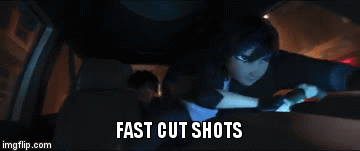
Sound:
This soundtrack is taken from the car chase action, where the non-diegetic sound of this music creates this sense of immediate action and Gogo's tomboyish persona, thus revealing her subverting the stereotypical roles of women. The use of the electric guitars from this music, further creates her cool, yet brave personality, as this reveals her spring to action in saving her friends and protecting the protagonist. Furthermore, it also reveals how Gogo's dangerous driving makes her a powerful character.
Click and hold the mouse up to 2:40 to hear the theme where Gogo Tomago begins her epic car chase speed.
Camera

This high angle shot reveals the action taking place, where GoGo Tamago (Jamie Chung) throws her hovering disk to the targeted antagonist. This effects helps viewers to feel that they are going to get hit from this advanced attack.

This over the shoulder shot reveals the conversation scene between Hiro (Ryan Potter) and Baymax (Scott Adsit).The use of this angle helps reveal that the characters are in a laboratory, thus conveys Baymax's current programming to fully become a medical robot. It also gives the viewers a more understanding of Baymax's kind character, as we see him handing a lollipop to Hiro.

This medium-long shot displays Hiro's (Ryan Potter) easy peasy demeanour while he was controlling his geometric robot in a robot battle against his opponent. This medium shot allows viewers to see the protagonists day to day life and his bored personality in taking part in robot fights.

This use of establishing shot helps reveal more of the mis-en-scene and the futuristic icons that are surrounding Baymax(Scott Adsit). The combination of the Japanese technology and the architecture of San Francisco creates this bizarre, yet interesting setting of how San Francisco will appear to look like in it's sci-fi props.

This high angle shot helps reveal the reason why Wasabi (Damon Wayans Jr.) stopped the car during a runaway. It also adds a comedy effect to GoGo Tamago's (Jamie Chung) shout to why there are "no red lights in a car chase", encouraging viewers to understand her reasoning and meaning of action.
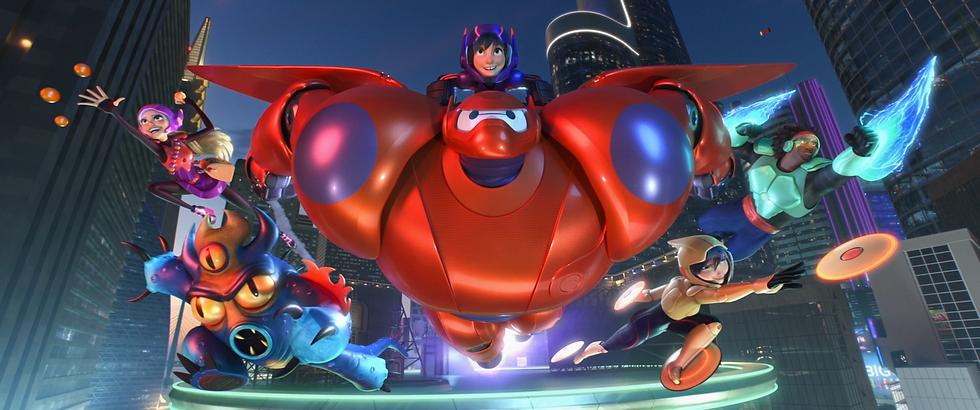
This low angle - wide shot displays the Big Hero 6 team, where we can see the colourful props and the character's features whom appear to be ready to spring into action. The background props of an advanced city, further represents the characters that they are heroes (heroines) who will protect the future against evil. This low angle makes the viewers feel that they are petite, as this angle makes the characters feel that they have the power and are fearless against upcoming villans.
Click the images to view the written text that explains about the use of these camera shots. When on image view, click the arrows that is displayed on the left/right screen to view the next slide.
Indiana Jones and the Raiders of the Lost Ark

Outline of Indiana Jones and the Raiders of the Lost Ark:
Indiana Jones (Harrison Ford) and the Raiders of the Lost Ark is a mixture of action and adventure.
Indiana Jones, a known travelling archeologists, is hired by the U.S. government to find the Ark of the Covenant, which is believed to still hold the fragments of the ten commandments that was smashed by Moses. Unfortunately, agents of Hitler are also after the Ark. Indy, and his ex-flame Marion, escape from various close scrapes in a quest that takes them from Nepal to Cairo. Jones's adventure was only the beginning.
Director: Steven Spielberg
This is a video clip of Indiana Jones attempting to collect the golden idol in a mysterious, isolated temple. This clip demonstrates the props of the ruins and how the fast pace creates tense and action to the scene where Jones escapes from the traps and the large bolder. Click the arrow at the centre to watch!

Jones (Harrison Ford) wears clothes that are similar to the Cowboy's fashion as depicted from the hat, since the setting of the story is part from the US. The clothes Jones wear is a little modern, since the setting of the story is somewhere around 1936 where the US is modernising. His appearance shows his fearless expression, as the brown coat convey Jones's ready for action and his desire to discover a new historical artefact.
Mis-En-Scene

Marion (Karen Allen) wears a plain t-shirt depicting her simple, archeological life. Her hand holding a golden artefact reveals her curious, yet observant persona which conveys that she may be a relic collector, as depicted from the cash on her right hand. The background shows that she maybe in a bar, which further depicts her adventerous side, similar to the protagonists role. Furthermore, she is the only woman who is an archeologist, thus conveying her to be a character who subverts the roles of women.
Editing:
From watching the video clip, where we get to see Jones escaping from the traps after collecting the golden idol, we see alot of fast pace cuts after the scene where Jones accidently activated a self-destruction trap. The use of the pace cuts allows viewers to feel tense of encouraging Jones to survive and allows them to know how an adventure like this could have some unexpecting things that prevents the protagonist to achieve his goal. Fast panning was also used to see the masked figures spitting out arrows, thus conveying on how these traps are very lethal. Furthermore, this panning also demonstrates that Jones is willing to take a risk that could be life threatening, thus matching the conventions of adventure films (risks can be challenging for the protagonsit).
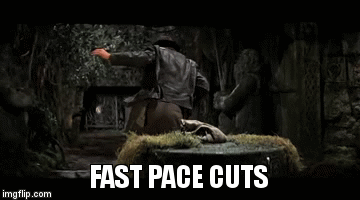
Sound:
From analysing the boulder trap scene, we can hear more of the diegetic sound of the boulder rolling towards Jones and his heavy breathing, than the non-diegetic sound of the music that adds tense to the viewers. The loud noise from the rolling boulder allows the viewers to know that the boulder is a large threat to Jones, which indicates to why Jones is running away from it with heavy breathing. Furthermore, as the non-diegetic orchestra ended to the scene where Jones is surrounded with rainforest natives, this indicates that there is an awkward, yet uncomfortable silence, which causes viewers to feel a sense of discomfort and as if they are surrounded aswell like Jones.
Camera
 |  |
|---|---|
 |  |
Click the images to view the written text that explains about the use of these camera shots. When on image view, click the arrows that is displayed on the left/right screen to view the next slide.